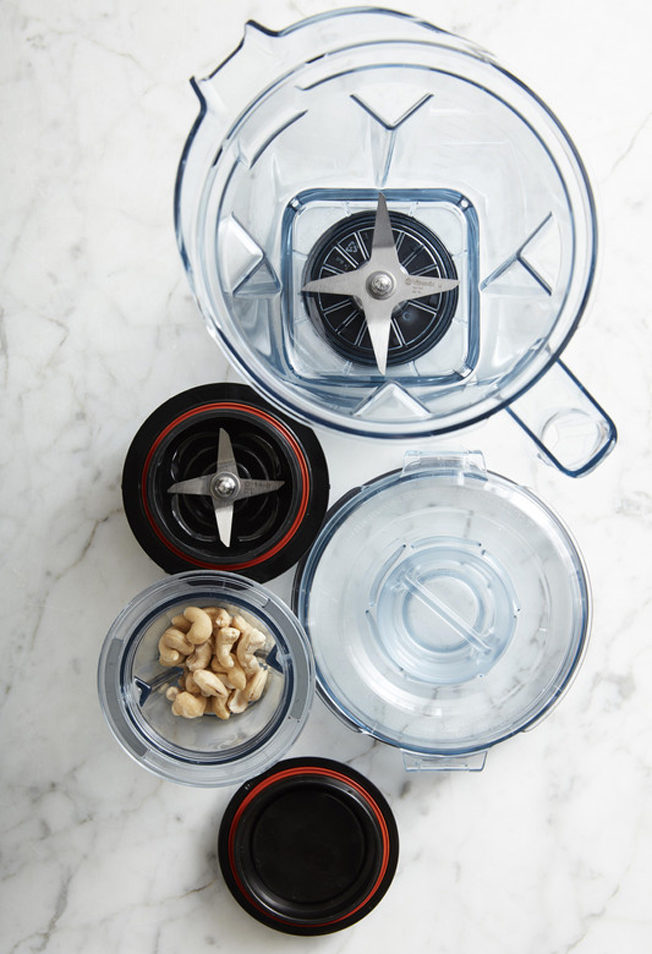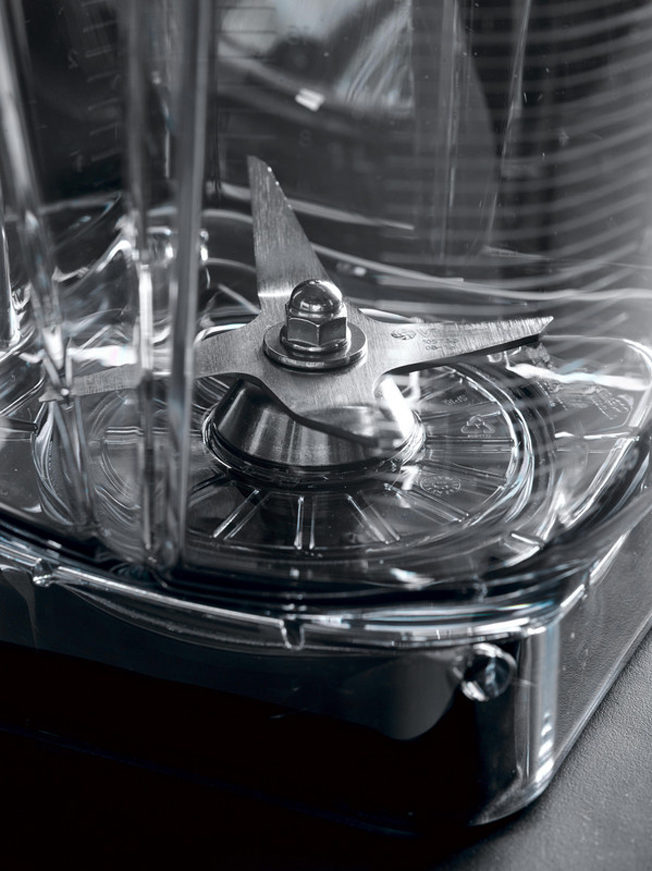
While the carafe of some newer models of Vitamix blenders are top rack dishwasher safe, to prolong the blender’s life and beauty, we don’t recommend running it through the dishwasher. Thankfully, there’s no need to, as cleaning your blender is ridiculously easy. Here, we’ve broken down the steps for quick-cleaning your blender as well as troubleshooting when your Vitamix needs a little extra TLC.
How to Quick-Clean a Vitamix

Everyday maintenance of your Vitamix is a breeze, provided you remember to clean it shortly after use. Follow these steps:
- Immediately after use, rinse the blender carafe with warm water. Add a few drops of dish soap to the carafe, and fill it halfway with warm water.
- Securely attach the lid, turn the dial to speed “1”, and start the machine. Slowly increase the speed to “high”, then run for 30 to 60 seconds. Return the dial to “1,” then turn off the machine.
- Dump out the blender’s contents, rinse with warm water, and air dry upside down.
- Separate the lid into two parts and wash with warm soapy water and a sponge, rinse clean, and air dry upside down. The same goes for the tamper (if used). These parts are also top-rack dishwasher safe.
How to Quick-Clean a Vitamix With a “Clean” Setting
If your Vitamix has a “clean” setting, everyday maintenance is even easier. Follow these steps:
- Immediately after use, rinse the blender carafe with warm water. Add a few drops of dish soap to the carafe, and fill it halfway with warm water.
- Securely attach the lid, select the “clean” setting, and start the machine. Your Vitamix will automatically shut off once the cycle has finished.
- Dump out the blender’s contents, rinse with warm water, and air dry upside down.
- Separate the lid into two parts and wash with warm soapy water and a sponge, rinse clean, and air dry upside down. The same goes for the tamper (if used). These parts are also top-rack dishwasher safe.
How to Deep Clean a Vitamix
Most of the time, the quick-clean procedure works wonders and is all that needs to be done to clean your blender. That said, it doesn’t work in all scenarios. If you wait too long to clean it, residue may dry onto the carafe, making it harder to remove, or perhaps a recipe has left your blender a sticky mess. First, try filling the carafe all the way up with warm soapy water, and allowing it to soak for an hour or two before proceeding with the typical cleaning procedure. For more troubleshooting techniques, see below.

How to Clean a Vitamix After Making Peanut Butter
Sticky and dense, peanut butter and other nut butters can provide an extra cleaning challenge. If the quick-cleaning procedure hasn’t worked, try a short soak, then use a small silicone spatula to remove as much of the nut butter from the carafe as possible, or, if you have one, use a soft bottle brush to manually clean the carafe. Then, dump out the contents, and run through the quick-cleaning steps using dish soap and warm water.
How to Eliminate Odors From a Vitamix
If your blender is smelling less than fresh, try the following:
- Fill the blender halfway with a 50:50 solution of warm water and white vinegar, proceed as if quick-cleaning your blender, rinse it out, then run through the quick-cleaning steps using dish soap and warm water.
- If the offensive odor persists, fill the carafe to the top with a 50:50 solution of warm water and white vinegar, let soak for at least four hours, or as long as overnight. After the soak is finished, dump out the contents, then run through the quick-cleaning steps using dish soap and warm water.
- If that still hasn’t done the trick, fill the carafe halfway with warm water, add 1 ½ teaspoons liquid bleach to the water, proceed as if quick-cleaning your blender, rinse it out, then run through the quick-cleaning steps using dish soap and warm water.
Removing Turmeric Stains from a Vitamix
Super-pigmented, turmeric tends to leave a telltale golden trace on everything it touches. (For this reason, we especially stress cleaning your blender shortly after use when working with turmeric.) To remove turmeric stains, first try using UV light to break down the stain by setting your Vitamix carafe out in the sun for a few hours. If that doesn’t work, fill the carafe halfway with warm water, add 1 ½ teaspoons liquid bleach to the water, proceed as if quick-cleaning your blender, rinse it out, then run through the quick-cleaning steps using dish soap and warm water. If stains still persist, try manually cleaning the carafe with a paste of baking soda and water applied with a clean, soft-bristled toothbrush, then rinse the carafe with soapy water per usual.

10 comments
Thanks so much for sharing, this has been super helpful!
A Vitamix is a powerful food processor. But how do you use it the right way? There are a lot of video Tour videos online that show how to clean a Vitamix. But they’re not really clear about how to keep your Vitamix clean.
I recently used Vitamix 5200 with very safe and clear all the time. It’s about how you use it.
[…] Everything You Need to Know About Cleaning Your Vitamix Can A Vitamix Go In The Dishwasher? […]
I have a 3 year old Acsent series Vitamix that instructions say or dishwasher safe. Obviously, you can’t put this in the top rack. I have used this blender at least 3 times a week and always put it in the bottom rack. It still looks brand new. I don’t care how easy it is to clean the blender with this method, it is still not as easy as putting it in the dishwasher which is why I chose this particular Vitamix. The blade part does go in the top rack.
Amazing blog about the foods and cutlery really writer have chosen the unique content in blog.
Great blog!!!1
I recently had food poisoning from an ingredient used in a smoothie using my vitamix. What’s the best way to disinfect it so that all contaminants are done away with and its safe to use again?
What do you suggest with heavy limestone residue? We don’t use toxic chemicals, so bleach isn’t an option. Thanks!
Great blog!
I use Young Living Thieves cleaning solution with white vinegar. Sparkling clean and sterilized!